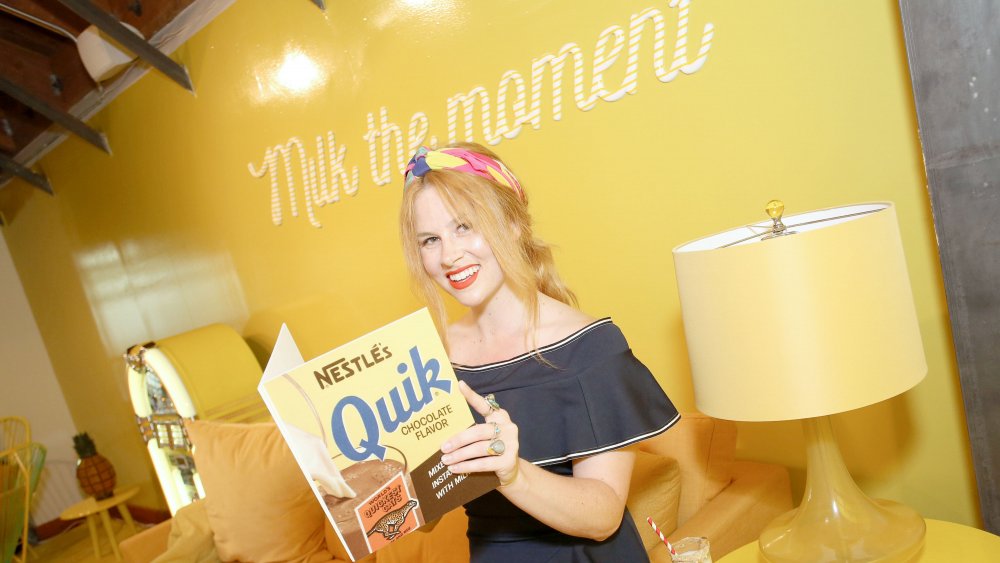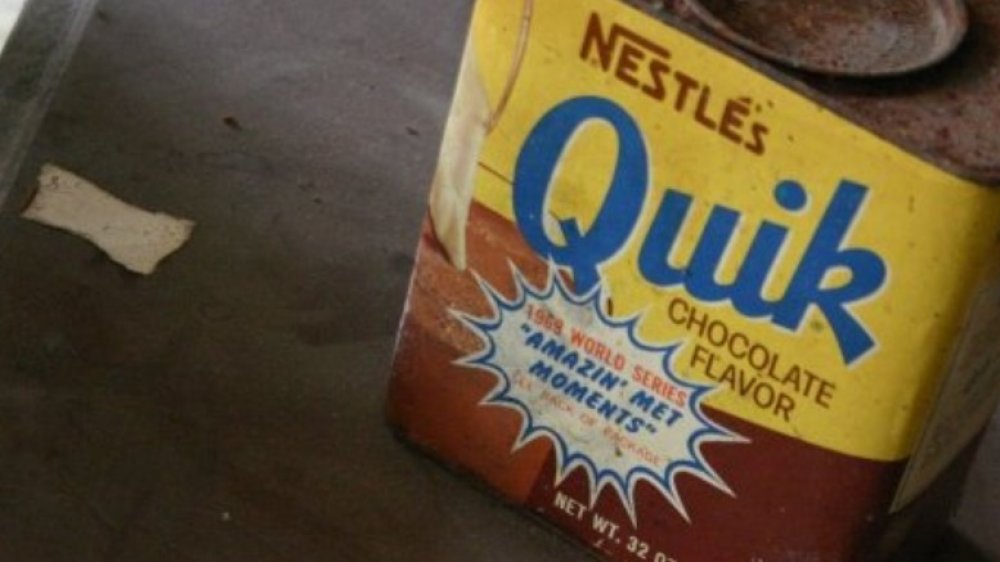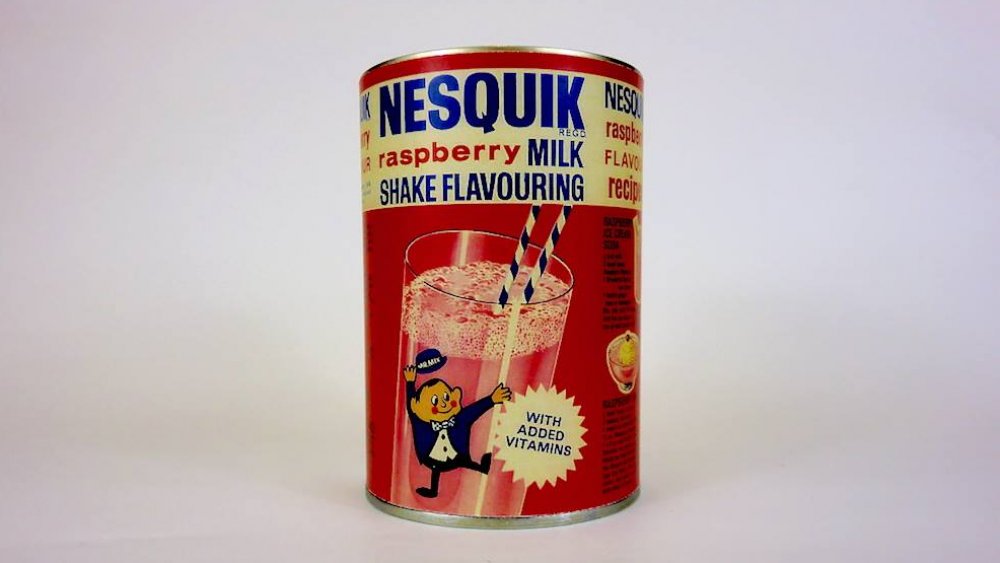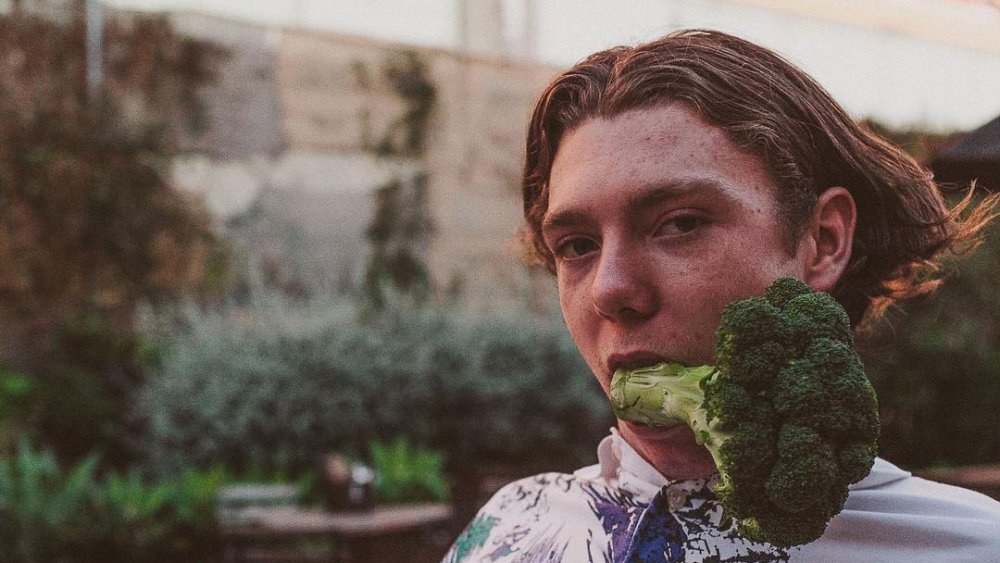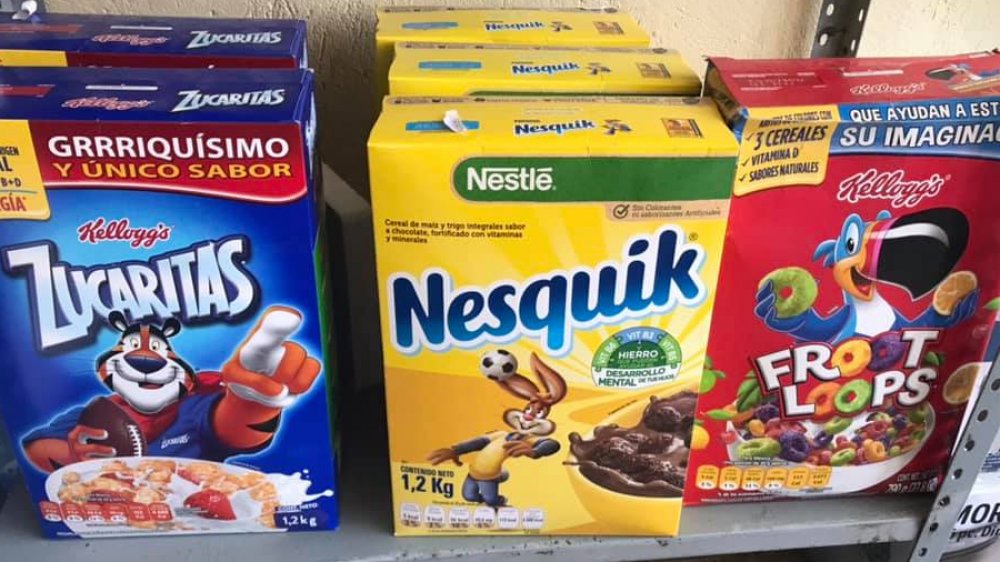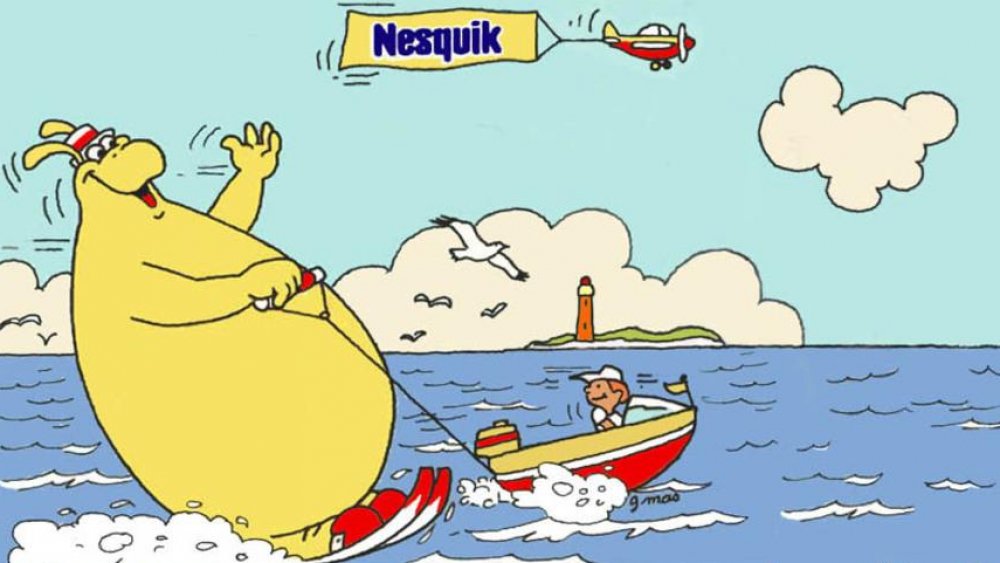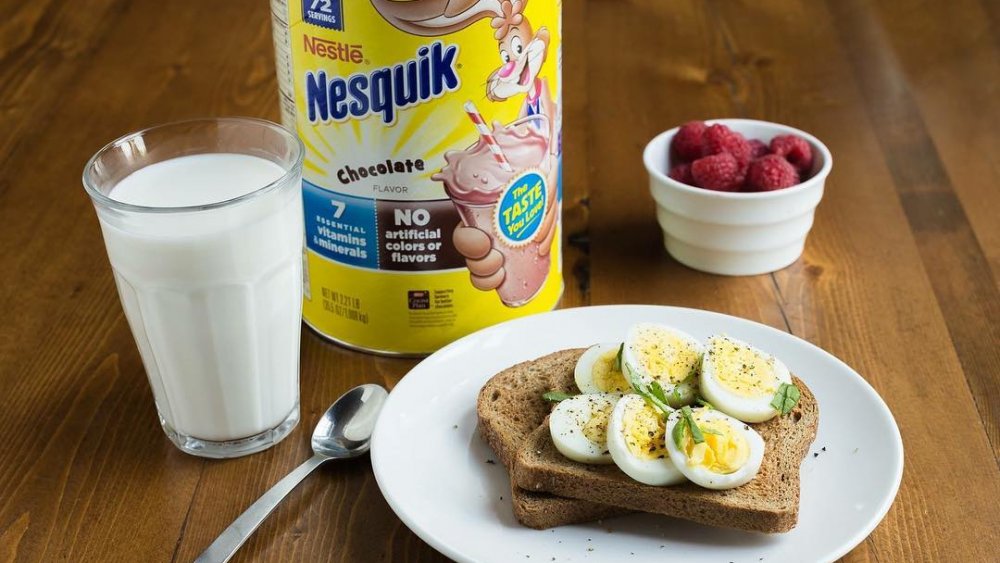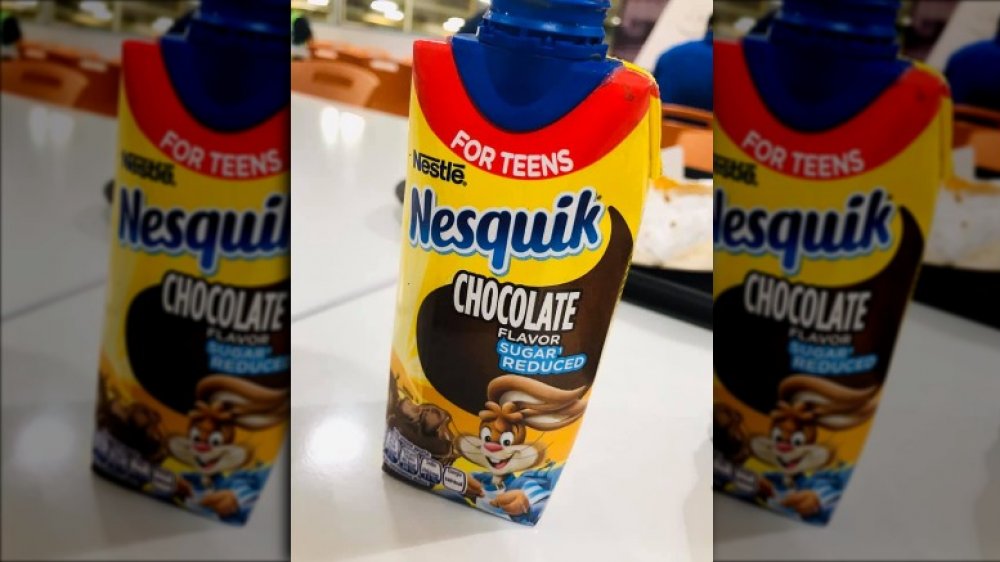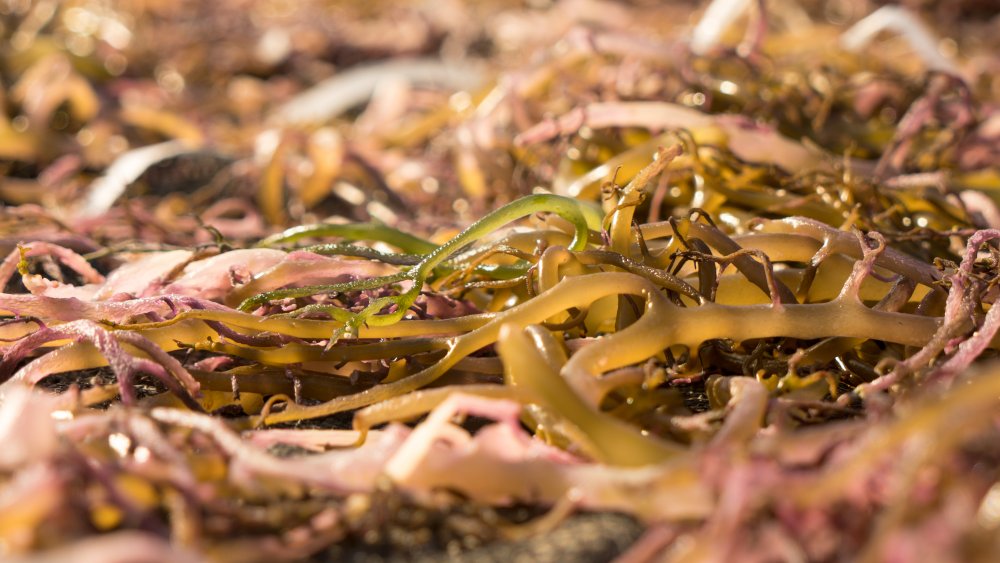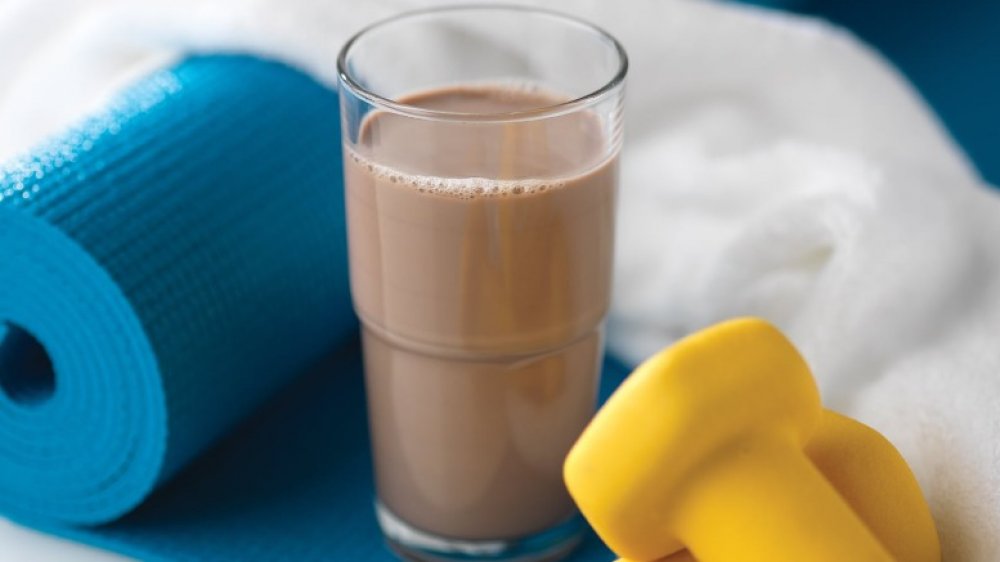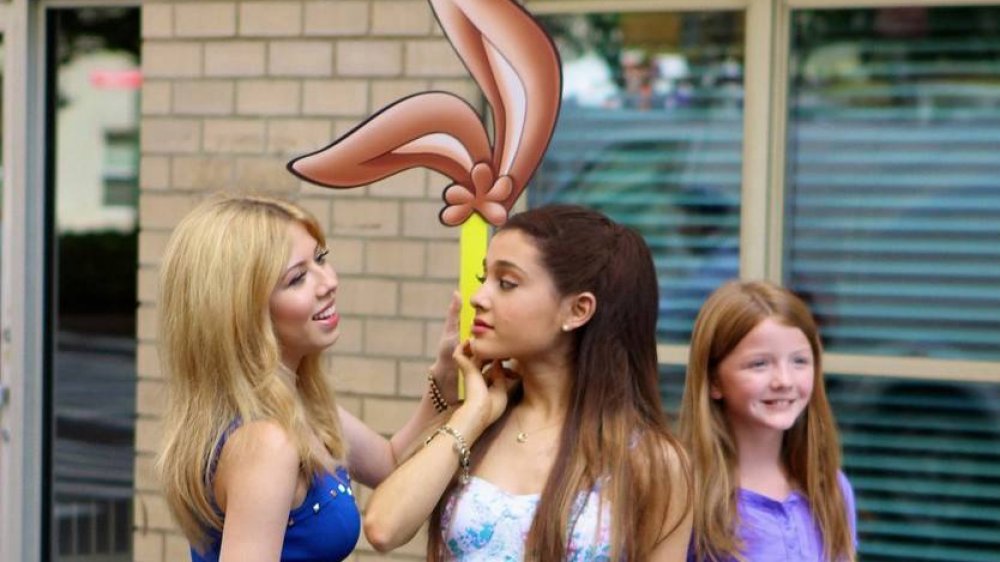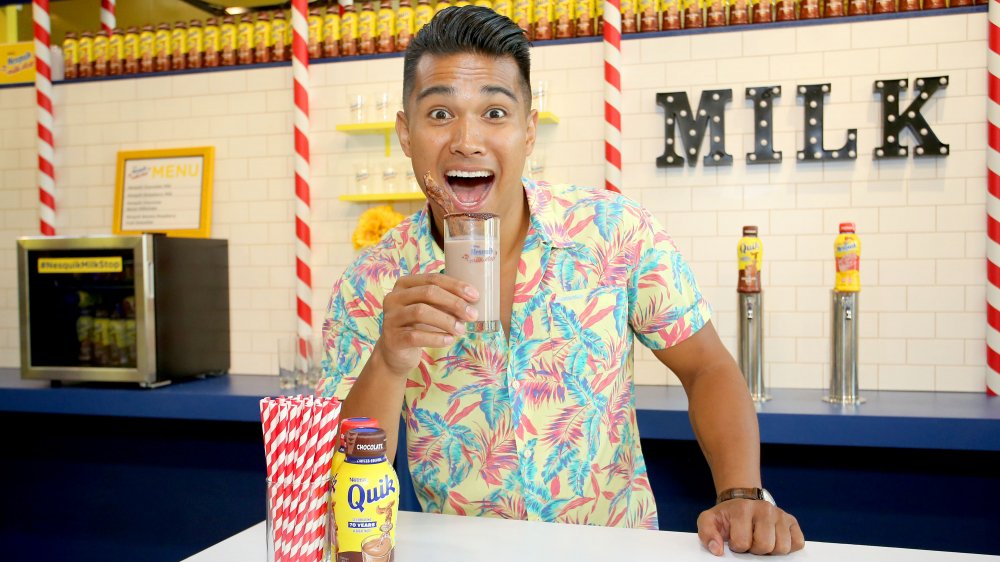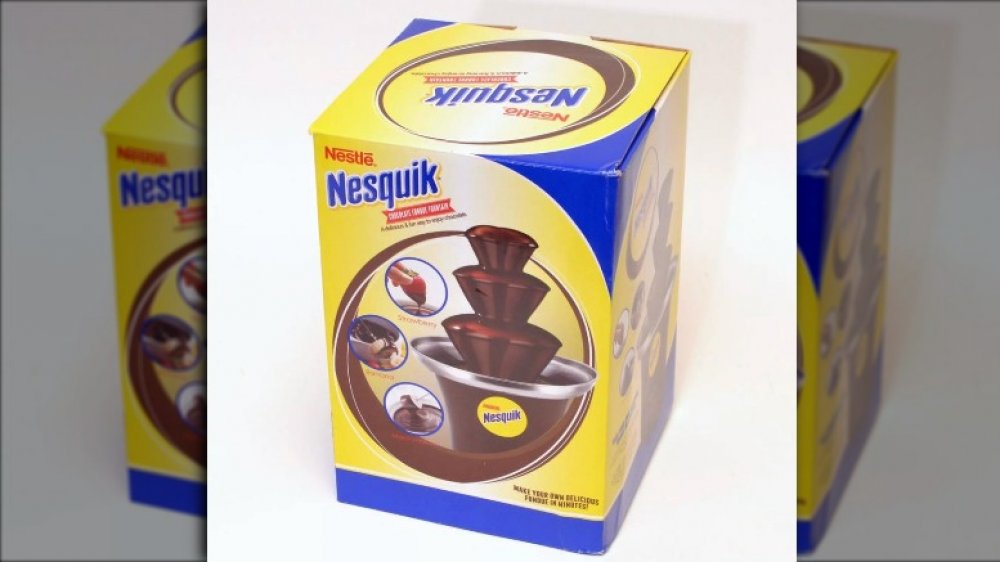The Untold Truth Of Nesquik
Depending on your generation and your origin, you likely grew up drinking either Nestlé Quik or Nesquik, made from either chocolate powder or chocolate syrup. Or maybe you just grabbed a bottle in its pre-chilled, ready-to-drink incarnation. Manufactured by Nestlé, the largest food company on the planet, Nesquik is one of those ubiquitous and transcendental products that seems to always have been comfortably present on supermarket shelves throughout the world (actually, it's only been 72 years). That said, like many other familiar faces, how much do you actually about the prized "billionaire" brand?
Over the years, Nesquik has undergone massive transformations as it's sought to evolve from an enticing means of getting kids to drink their milk (by adding cocoa and indecent amounts of sugar) to a protein-powered recovery drink stuffed with "nourishing nutrients." Along the way, it's experienced mega-successes as well as epic fails. For all the love, accolades, and social media like it's garnered, it's also been on the receiving end of criticism, blowback, and lawsuits. We rounded up some of the more interesting and unknown facts about the beloved and sometimes controversial brand below.
Nesquik tins from 1969 are worth over $150
In 1948, when Nestlé first launched its chocolate powdered flavoring mix in the U.S., it did so under the name Nestlé Quik. Soon after, the product was introduced to the European market under the name Nesquik. For decades, both names co-existed compatibly until 1999 when Nesquik triumphed, becoming the universal brand name.
This micro-history lesson explains why, in 1969, Nesquik was being sold in America in two-pound (32-ounce) tin canisters that bore the name "Nestlé Quik." However, it doesn't explain why today these tins are coveted by collectors who will pay up to $200 to find one in mint condition.
In 1969, the New York Mets were baseball's uber-underdog, infamous for setting "enduring records for incompetence." Yet, bucking all expectations, in October, the team came out from behind the Baltimore Orioles to win the World Series. The unexpected champions were christened the "Miracle Mets." The team's popularity was such that Nestlé jumped on the Mets bandwagon by creating a commemorative series of collectors' canisters. The front of the canisters touted "Amazin' Met Moments" in bold, blue capital letters. The back featured painted portraits of six Mets heroes along with recaps of their "Amazin'" feats on the field for each of the five World Series games played.
According to auction experts, the rarity of these commemorative canisters, combined with their appeal to collectors of vintage food containers and baseball memorabilia, has made them a sought-after item.
A lot of Nesquik flavors have bombed
Although Nesquik and chocolate are as inseparable as Trump and Twitter, the brand has dabbled with many other flavors over the years. Some — notably strawberry and banana (not to mention strawberry-banana) — have been enduring hits. However, a surprisingly long list of others haven't fared so well, to the point of being discontinued.
Among Nesquik's flavor rejects are some relatively inoffensive options that still seem like good ideas such as Nesquik Honey Powder, Caramel Powder, and Vanilla Powder (which managed to survive in ready-to-drink form). Nesquik Cream Powder may have been too tame and/or redundant (mixing cream with milk?). Although more intriguing and ambitious, Nesquik Crème Soda Powder and Cookies and Cream Powder may have suffered from the same redundancy.
At the bolder end of the flavor spectrum, Nesquik Triple Chocolate Powder possibly erred in terms of excess (that said, Nesquik Double Chocolate Lowfat Milk is alive and drinkable). And who knows why Nesquik Grape Powder, Cherry Powder, and Mango Powder got the boot? While they sound promising, could it be that these somewhat acidic fruity flavors didn't translate well into milk mixtures? Even toning down the "zing" of orange with tried-and-true chocolate wasn't enough to save Nesquik Jungle Jaffa Powder from extinction.
All in all, chocolate has proved to be Nesquik's safest bet. Perhaps this explains why, in early 2020, the latest recruit to Nesquik's flavor team was Hot Fudge Sundae Powder.
Nesquik once fake-hyped a new broccoli-flavored drink
Just because Nestlé is the world's largest food company with revenues of $304.1 billion doesn't mean the mega-multinational company doesn't have a sense of humor. In 2013, Nesquik took to Facebook to announce the introduction of a new Nesquik flavor: Broccoli Milk, whose label included the familiar Nesquik Bunny mascot holding a giant glass overflowing with liquid greenness. Despite the disclaimer and the date — April 1 — followers (especially those clueless to the fact they were being pranked) were not impressed. Comments ranged from "disgusting... poor kids" to "im sure it a joke but still not funny thats nasty as hell."
Even though Nesquik was only kidding, it seems that it was actually onto something! Flash forward a few years, and broccolattes (i.e.. broccoli lattes) are actually a thing (at least in Australia). In response to research showing that average Australians weren't getting their recommended daily intake of veggies, Australia's national science agency, CSIRO, co-developed the broccoli powder and the drink. The plan was to lure Aussies into consuming more nutrient-packed vegetables while wasting less food (broccoli powder is made from the whole plant, including "ugly" parts usually thrown away).
Despite impressive amounts of protein and fiber, reactions to broccolattes have been "mixed." As Delicious stated, the downside to the broccoli latte is that it tastes like broccoli.
U.S. Nesquik cereal junkies want their cereal back
Americans of a certain age remember the year 1999 with a certain nostalgia. The many momentous firsts that occurred on the eve of the new millennium included the airing of the first episode of SpongeBob SquarePants, the launch of the first consumer Bluetooth, and the roll-out of Nesquik cereal in the U.S.
Based on the already popular Nesquik chocolate milk mix, the chocolate-flavored puffed rice and corn cereal was the hybrid brainchild of Nestlé and General Mills. Early TV ads promised breakfasting Americans "a chocolatey blast for you and your milk," and many became hooked on the cereal.
However, in 2012, the blast petered out when Nesquik cereal supposedly vanished from U.S. supermarket shelves. That the cereal is still sold and eaten in countless countries around the world (including neighboring Canada and Mexico) has been a source of both envy and relief for fans who go to great lengths to get their hands on a box.
Amazon hawks Nesquik cereal online for US$12, which doesn't include shipping costs from the UK. (The high expense has led one devotee to hide her imported stash from her own husband). Social media has become a protest zone where American consumers decry the absence of Nesquik cereal and circulate petitions imploring Nestlé to bring it back. Although Nesquik posts sympathetic replies, to date it hasn't relented to popular demand.
Quicky the rabbit isn't Nesquik's only beloved mascot
In the 1950s, Nestlé launched its Quik Strawberry Powder in the U.S. Customers weren't just curious about the new flavor — they also wondered at the cartoon pink rabbit featured on the packaging. His identity would remain a blank until 1973 when the bunny not only starred but played electric guitar in his debut Nesquik commercial for the brand. The performance of this earworm jingle was such a success that he became the official brand mascot under the name Quicky the Nesquik Bunny.
Quicky subsequently took the world by storm. But there were a few European hold-outs who rejected the American bunny in favor of their own pre-existing Nesquik mascots. In France and Greece, fans favored a large, fat yellow cartoon monster of indeterminate animal origin, known in French as Groquik ("Fat Quik") and Quikáras ("Big Quik") in Greek. Portugal inexplicably opted for a Nesquik-swigging cartoon kangaroo named Cangurik. Italy kept things simple, if a little unimaginative, with an animated box of Nesquik named Mr. Nesquik.
But it wasn't long, however, until the Nesquik Bunny had replaced them all. Quicky morphed in hue from his original strawberry pink to a chocolatey brown. Subsequent makeovers included a radical transformation from old-school quirky cartoon to slick CGI rabbit. Even so, decades later, there's still a lot of social media love for the underdog Nesquik mascots that didn't make the cut.
Nesquik has gotten into hot water over misleading claims
Despite claims that it provides "nourishing nutrients" to the masses, over the years, Nesquik has faced some unsavory legal issues as activists have spoken out against its controversial health claims.
Among the most talked-about was a 2015 ad for Nesquik hot chocolate, which was banned by Britain's Advertising Standards Authority (ASA). The UK's advertising watchdog found that Nesquik's claim that the product gave children a "great start to the day!" was misleading due to the drink's high sugar content. As BBC News reported, by suggesting health benefits without offering verifiable health claims, the ad was in contravention of European law.
Nestlé recognized that a 200-ml drink made with three teaspoons of Nesquik hot chocolate contained "high" sugar levels. However, it also stated that half of this sugar came from lactose in the milk. Less convincingly, a spokesman argued that the ad's appearance on a family-sized milk bottle was obviously targeting adults, making it clear that the product "should be consumed over a number of days, rather than in excess."
As stressed in The Guardian, even less convincing was the company denying that the Nesquik Bunny was the ad's main focus, while simultaneously referring to it as "a physically active, energetic character who could promote a healthy lifestyle." Malcolm Clark, who coordinated the campaign against Nesquik, wasn't impressed. Declaring the ad encouraged poor nutritional habits in kids, he observed that "Nesquik's old bunny hasn't yet learned new healthier tricks."
After backlash, Nesquik slashed half its sugar
The UK ad episode was only one prominent example of mounting pressure that nutritionally woke consumers were exerting upon Nestlé. According to MarketWatch, by the 2010s, Nesquik was at "the epicenter" of a battle over sugar content.
To get with the program, Nestlé decided to flex its research and marketing muscles to boost "lackluster" revenue growth. In 2015, it launched a reduced-sugar version of Nesquik in the U.S., decreasing sugar content in chocolate and strawberry powders (by 15 and 27 percent, respectively). While Nesquik ready-to-drink beverages also saw their sugar reduced to 10.6 grams, but when you factor in the naturally occurring sugars of lactose, it elevates total sugar content to 22 grams.
Excising sugar without sacrificing flavor wasn't a Quik task for the ten Nestlé scientists who carried out countless experiments on new ingredients. Yet their hard work paid off. Nesquik's U.S. market share increased following the initial sugar reduction. From 2007 to 2017, Nestlé cut 39,000 tons of sugar from its products while pledging to cut another 18,000 tons between 2017 and 2020 in Europe alone.
Big numbers aside, consumer advocacy groups remained unimpressed. As Michael Jacobson, former executive director of the Center for Science in the Public Interest declared, "It's a nice step in the right direction, but it's not a huge victory for nutrition."
Nesquik contains (not-so-healthy) red seaweed
Once Nesquik slashed its sugar levels, there was growing consensus that moderate consumption of its products was "not as bad for you as one would think." While the relatively high sugar content remained a problem, consumer activists were also worried about a secondary preoccupying presence: dried red seaweed.
Ordinarily, the words "organic" and "seaweed" conjure up antioxidant-, fiber-, and mineral-rich healthy eating. However, carrageenan, the processed red seaweed found in Nesquik, is not quite so virtuous. Extracted from seaweed commonly known as Irish Moss, carrageenan has been used in traditional cooking for centuries. More recently, it's also been used by the food industry as an emulsifier that thickens and holds together liquids. Most prominently, it turns up in ice cream, puddings, yogurts, and non-dairy milks.
Over the years, a growing number of scientists and food activists have pointed to studies showing that carrageenan is highly inflammatory and bad for the digestive tract. There are claims that it may contribute to conditions ranging from mild bloating, irritable bowel syndrome, and ulcerative colitis to rheumatoid arthritis and even colon cancer. Other scientists have countered that these animal-based studies featuring injected carrageenan are misleading and flawed.
While the FDA has refused to remove it from the list of ingredients "generally recognized as safe," the National Organic Standards Board removed carrageenan from its list of approved products, meaning such foods can't be labeled "USDA organic." And so, for the moment, the carrageenan controversy continues unresolved.
Turns out Nesquik is an ideal post-workout drink
Despite the frequent lack of faith in its healthy intentions, Nesquik has continued, undaunted, along the road to wellness. Aside from reducing the sugar content — even releasing Nesquik No Sugar Added Powder (which angry consumers observed contained artificial sweeteners) — Nesquik also stopped using artificial colors and flavors in its powdered products.
These days, Nesquik touts itself as a recovery drink. In fact, a growing number of sports science experts believe it may be the best recovery drink on the market, with the ideal carbohydrate-to-protein ratio needed for muscles to restore their glycogen levels.
Funnily, according to The Guardian, chocolate milk's impressive restorative properties were discovered by accident. During a scientific study to evaluate the performance of leading sports drinks, some elite cyclists were given the sports drinks while others received milk. To everyone's surprise, the milk-guzzling cyclists significantly outperformed all the others. Further experiments revealed that chocolate milk performed even better than unflavored milk, due to its being naturally tuned to human digestive systems.
Perhaps most surprising of all is that the one big gripe about chocolate milk (and Nesquik) — its sugar content — actually plays a key role in athletes getting their required post-workout carbs. As The Guardian explains, chocolate milk has around three times the carbs of regular milk, making it something of a sweet, if unexpected, hero.
Ariana Grande couldn't save Nesquik from epic failure
In a 2018 post published by the Valcourt Group, author Chuck Thomas included Nesquik among a roster of mega brands including Coke, Ford, and Microsoft on his round-up of "25 epic strategic marketing fails."
In the case of Nesquik, Thomas concedes that its 2013 "National Bunny Ears Day" campaign actually started out as a good idea that drew upon the Nesquik Bunny's widespread popularity. To play up the bunny love, Nesquik devised a Bunny-Fier iPhone app that "bunny-fied" users' pics by adding a pair of long rabbitty ears to photos. It also declared September 16 to be "National Bunny Ears Day." In commemoration of the date, "bunny ear enthusiasts" were invited to post bunny-fied pics of themselves to Instagram and Twitter using the hashtag #NationaBunnyEarsDay.
To drum up enthusiasm, Nesquik enlisted pop stars Ariana Grande and Jennette McCurdy to get the ball rolling by photobombing each other with Nesquik Bunny ears in a 30-second commercial. However, despite their best "Break out the Bunny" efforts, the first-ever National Bunny Ears Day was a flop. Embarrassingly, the hashtag only received two Instagram posts and nine Twitter mentions (one of them a selfie taken by celebrity chef Giada De Laurentiis of her and a bunny-eared Bobby Flay).
Having promised to feature some of the best bunny pics on Facebook, Nesquik never even got around to creating a photo gallery. Needless to say, Nesquik's first "National Bunny Ears Day" was also its last.
Nesquik celebrated 70 years with candied bacon shakes
Nesquik seemingly learned some valuable lessons from the "Bunny Ears" bust. In 2018, to commemorate its 70th birthday, Nesquik's marketing team decided to create its first live, pop-up event. The Nesquik Milk Stop was held at LA's Third Street Promenade. For an entire week, visitors could zoom down a giant straw slide and take selfies holding Nesquik umbrellas against a backdrop of Nesquik chocolate and vanilla rain. They could also sample lots of Nesquik.
The event's biggest buzz was generated by restaurateur and Cooking Channel host Jordan Andino. A self-declared "legit fan" of Nesquik, Andino's earliest memories of his childhood in the Philippines include eating champorado, a sweet rice porridge that his family flavored with Nesquik Chocolate Powder. For the event, Andino crafted two commemorative Nesquik drinks. His candied bacon milkshake had a nostalgic feel with the indulgent comfort food flavors amped up with pureed candied bacon and a salted Nesquik rim. His banana raspberry smoothie, on the other hand, seemed to highlight that Nesquik could be used for healthier recipes.
This time, Nesquik's strategy paid off. According to former marketing manager Jackie Jimenez, not only did the event receive four times more visitors than expected, but it also received 300 public posts on social media (289 more than it got for National Bunny Ears Day).
Imagine a fountain spouting Nesquik syrup
Considering our collective love for both gadgets and chocolate, it's surprising that the chocolate fountain wasn't invented until 1991. Like many transformative inventions that originated in Canada, this one was the brainchild of Quebec-based Design & Realisation. And like many other Canadian inventions, it didn't take off until it was launched in the U.S.
According to Exclusive Chocolates, early chocolate fountains were commercial ones used at hotels and catered events where they quickly became enormously popular. Granted, it's hard to resist the spectacle of a 50-foot tall, multi-tiered fountain from which 35 pounds of melted chocolate is cascading. Soon, consumers wanted to reproduce the experience at home, albeit on a less epic scale (home fountains are usually under 19 inches tall and hold less than six pounds of chocolate).
Viewed its rich chocolate reputation, it was a no-brainer when Nesquik decided to dive into chocolate fountains. Teaming up with Smart Planet, it launched the triple-tiered Nesquik Mini-Chocolate Fountain. Lauded for its cuteness and compact size, consumers on Amazon were less taken with its functionality, including its capacity to melt chocolate.
In its defense, Exclusive Chocolate explains that melted chocolate can be "very temperamental" and that few chocolate fountains are capable of melting chocolate directly in their basins. Due to home chocolate fountains' tricky fluid dynamics — a subject that has inspired academic studies — it actually makes scientific (not to mention economic) sense to use liquid chocolate such as Nesquik's chocolate syrup.
